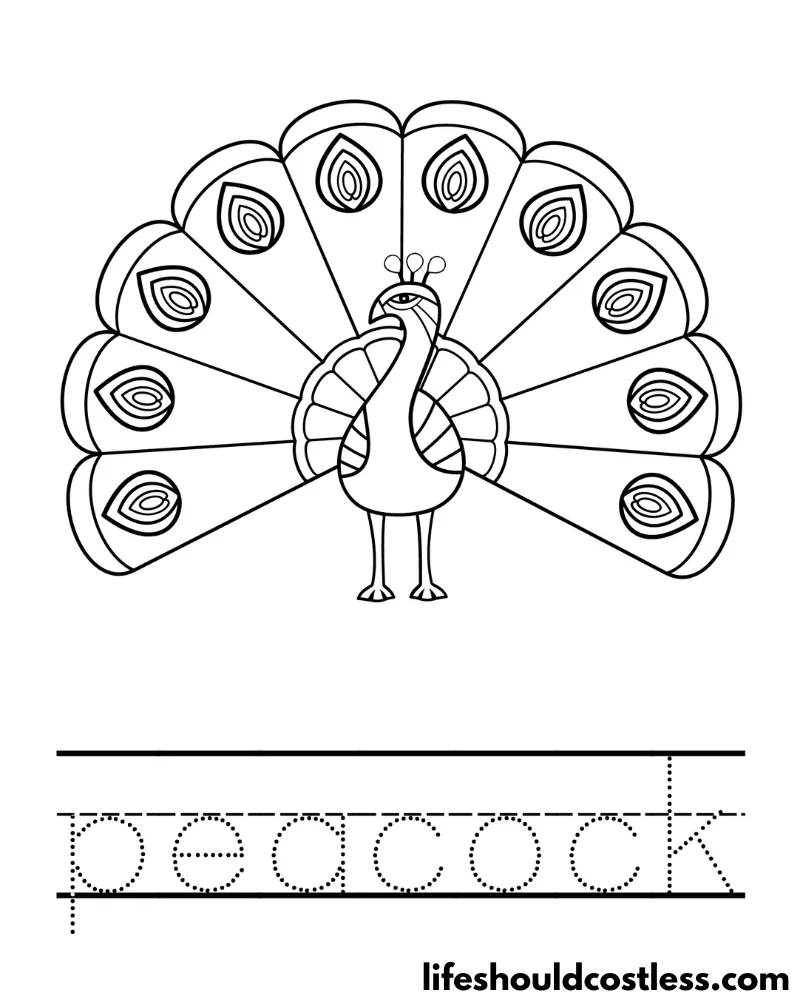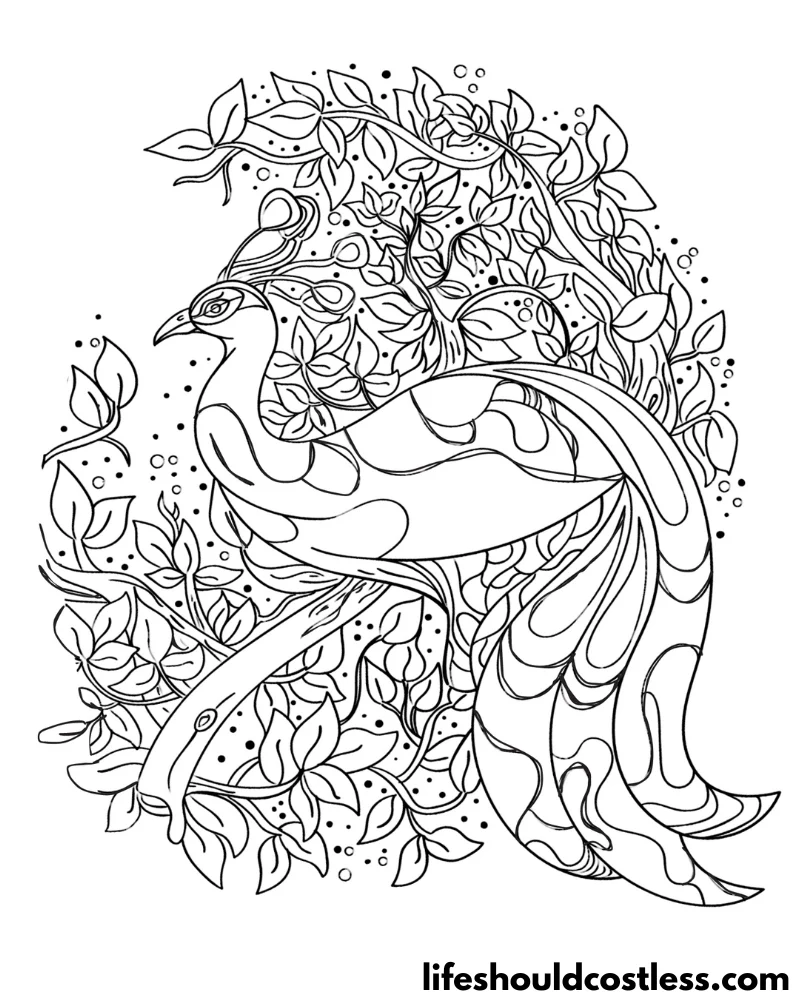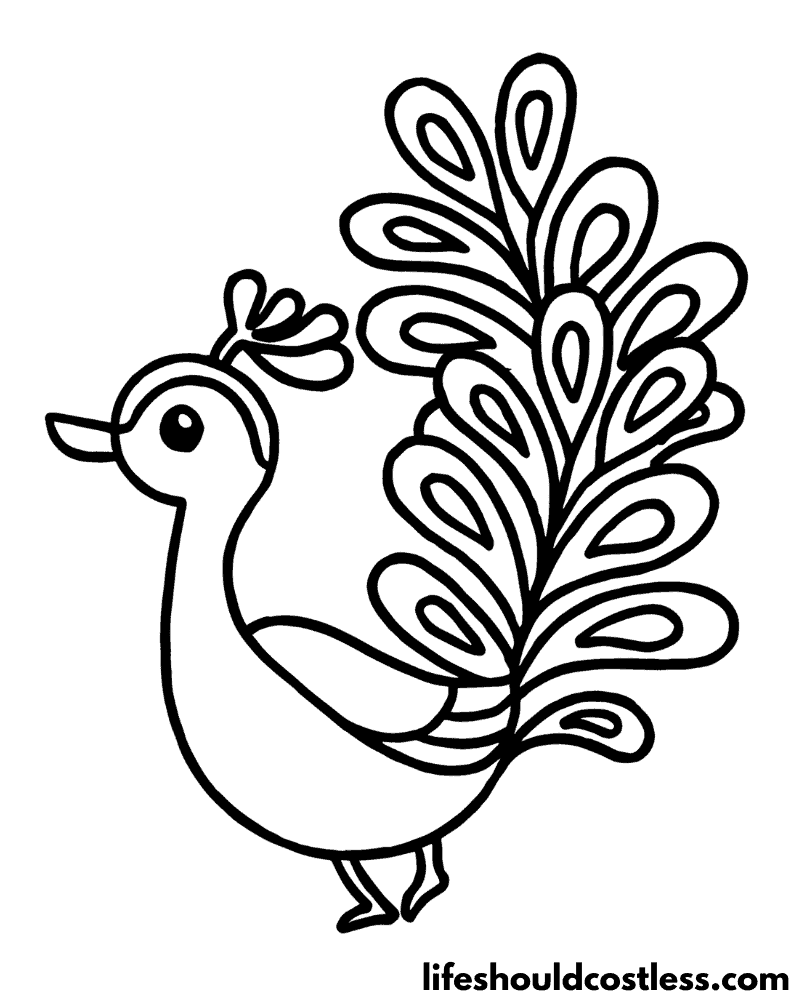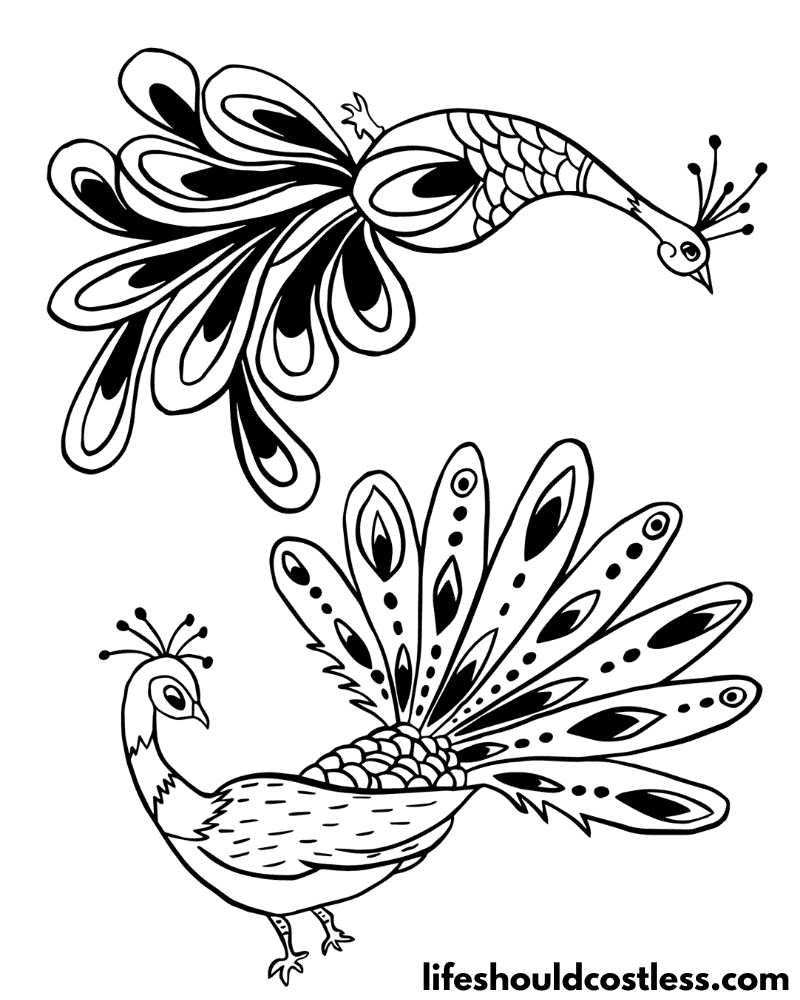If you’ve ever been mesmerized by the beauty of peacocks, then this collection of coloring pages is tailor-made for you. These graceful and majestic birds have long been admired for their stunning plumage and enchanting presence, and now, you have the opportunity to bring them to life with your own artistic flair. Whether you’re a child, an adult seeking a relaxing pastime, or an art enthusiast looking for a new creative challenge, these peacock coloring pages offer a wonderful way to explore your artistic abilities while celebrating the elegance of these magnificent creatures, all while learning about them. So, pick up your coloring tools and embark on a colorful journey into the world of peacocks!

Simply choose the design that appeals to you the most, download the free PDF template, print it out, and unleash your creativity by coloring to your heart’s content.
Alternatively, you could also utilize the designs as embroidery patterns or draw inspiration from them for fine line tattoos.
Peacock facts
If you’re new to my coloring pages, let me share that I always provide the opportunity to explore and learn about the subject, allowing you to seamlessly turn your coloring session into an educational experience.
So, get ready to embark on this enriching journey, combining creativity with knowledge! Let’s dive in together!
Here are lots of fun and interesting, simplified facts about peacocks (my reference source can be found here):
- Peacock vs. Peafowl: The term “peacock” technically refers to the male of the species, while “peafowl” is the general term used to describe both males and females. The male peacock is renowned for its vibrant and iridescent plumage, while the female, known as a peahen, has more subdued feathers.
- Dazzling Plumage: The male peacock’s tail feathers, known as the “train,” can reach up to 5 feet (1.5 meters) in length. These striking feathers are adorned with eye-catching iridescent colors, such as iridescent blues, greens, and purples, and have a distinctive “eye” pattern at the end.
- Courtship Displays: During mating season, male peacocks perform elaborate courtship displays to attract peahens. The display involves spreading their tail feathers in a stunning fan-like pattern and shaking them to create a mesmerizing spectacle. This courtship dance is one of the most iconic behaviors of peacocks.
- Tail Feathers as a Signal: The vibrant colors and eye-catching patterns of a male peacock’s tail feathers serve as visual signals to attract potential mates and establish dominance among rival males.
- Peafowl Species: There are three main species of peafowl: the Indian Peafowl (Pavo cristatus), the Green Peafowl (Pavo muticus), and the Congo Peafowl (Afropavo congensis). The Indian Peafowl, native to the Indian subcontinent, is the most well-known and widely recognized species.
- Roosting Habits: Peafowls are highly arboreal birds, which means they prefer to perch and roost on trees during the night for safety from predators.
- Vocalizations: While peacocks are often admired for their beauty, their vocalizations can be quite loud and raucous. They produce loud, high-pitched calls that sound like “meow” or “miao,” especially during the breeding season.
- Adaptability: Peafowls are adaptable birds and can thrive in various environments, including forests, grasslands, and even near human settlements.
- Diet: Peafowls are omnivores and have a varied diet. They mainly consume plants, seeds, fruits, insects, and small vertebrates.
- Lifespan: In the wild, peafowls can live for around 20 years, while those in captivity may live even longer due to improved living conditions and medical care.
- Symbolism and Culture: Peacocks have been revered and symbolized in many cultures throughout history. In Hindu mythology, the peacock is associated with gods and goddesses. In ancient Greece and Rome, peacock feathers were considered a symbol of immortality and renewal.
- Introduced Species: Due to their beauty, peafowls have been introduced to various regions around the world, including the United States and other countries. In some areas, they have established feral populations.
- Family Structure: Peafowls are social birds and often form small groups called parties or musters. These groups may include multiple peahens and their offspring, led by a dominant male.
- Limited Flying Ability: Despite their impressive tail feathers, peafowls are not strong fliers. They prefer to travel on foot and use their wings mostly for short flights to escape predators or reach roosting spots.
- Cultural Depictions: Peacocks have been depicted in various forms of art, literature, and mythology throughout human history, symbolizing beauty, pride, and extravagance.
These are just a few of the many intriguing facts about peacocks.
Their beauty, behaviors, and cultural significance make them a fascinating subject to explore and learn about.
If you would like to learn more about peacocks, here are some other reputable resources to learn about them while coloring:
- https://kids.britannica.com/kids/article/peacock/353606
- https://kids.nationalgeographic.com/animals/birds/facts/indian-peafowl
- https://nationalzoo.si.edu/animals/common-peafowl
- To see all of my free printables, go here.
- To see an alphabetized index of all of my coloring pages, go here.
- To see all of my Animals coloring pages, go here.
- To see all of my Birds coloring pages, go here.
Coloring tips
Coloring a picture of a peacock can be a delightful and creative experience.
Here are some of my best tips and tricks to make your peacock artwork really stand out:
- Observe Real Peacock Photos: Look at real peacock photographs to get a sense of their natural colors and patterns. This will help you choose more realistic or imaginative color combinations.
- Use Iridescent Colors: Peacocks have iridescent feathers that shine and change colors with light. Experiment with metallic or pearlescent colored pencils or gel pens to mimic this stunning effect.
- Layering and Blending: Build up layers of colors to achieve depth and texture. Experiment with light and dark shades to create dimension in the feathers.
- Highlight the “Eyes” on the Feathers: The “eyes” at the end of the peacock’s tail feathers are iconic. Make them pop by using brighter or contrasting colors around them.
- Add Shading: Pay attention to light sources and add shading to create a three-dimensional look. This can be done with subtle gradients or by varying pressure on your coloring tools.
- Embrace Creativity: Don’t feel restricted to realistic colors. Peacocks have beautiful plumage, so feel free to use a variety of vibrant and bold hues for a more artistic interpretation.
- Experiment with Mixed Media: Combine colored pencils, markers, gel pens, or watercolors to add different textures and effects to your peacock artwork.
- Try Different Paper: Use a smooth, high-quality paper specifically designed for coloring to prevent smudging and bleeding. It will also make blending and layering easier.
- Reference Nature: Look at peacock feathers or images for inspiration when coloring the intricate patterns. This can add authenticity to your coloring.
- Add Background Elements: Consider adding a complementary background to your peacock picture. It could be a simple pattern, foliage, or even a landscape to enhance the overall composition.
- Take Breaks: Coloring intricate designs can be time-consuming, so take breaks to rest your eyes and maintain focus on the details.
- Frame Your Masterpiece: Once you finish coloring, consider framing your artwork. It will be a great way to display your talent and add a touch of beauty to any room.
Remember, coloring is about having fun and expressing your creativity.
Don’t be afraid to try new techniques and explore different color combinations to make your peacock coloring pictures truly unique and stunning!
Options For Printing:
Letter P is for peacock writing practice worksheets
*My letter P is for peacock coloring sheet printables are specifically designed to be used in a classroom setting, they are the only printable options on this page that do not need written permission to use in a public setting.
Please send the link to this post along if anyone asks you where you got them. Thank you!


Various Peacock Designs









FAQ’s
The real color of a peacock’s plumage can be described as a combination of iridescent and vibrant hues. The most well-known species, the Indian Peafowl (Pavo cristatus), has a stunning and colorful appearance.
The male peacock, also known as a peafowl, is the one with the extravagant plumage. His head and neck are typically a metallic blue or green color. The back and breast feathers have a mix of shimmering greens and blues as well. The most distinctive feature is the “train,” which consists of long tail feathers. These feathers have a beautiful iridescent quality and showcase a captivating range of colors, including deep blues, greens, and purples, all with eye-catching “eye” patterns at the ends. The colors appear to change depending on the angle of light, creating a mesmerizing effect.
On the other hand, the female peafowl, known as a peahen, has a more subdued appearance. She lacks the long and vibrant tail feathers of the male. Her plumage is predominantly brown and green, which helps her blend into her surroundings for better protection when nesting.
It’s worth noting that peafowls are highly variable in their colors, and their appearance can be influenced by factors such as age, health, diet, and genetics.
Additionally, there are other species of peafowls, such as the Green Peafowl (Pavo muticus) and the Congo Peafowl (Afropavo congensis), each with its unique and distinct coloration.
In summary, the real color of a peacock, especially the Indian Peafowl, is a remarkable display of iridescent blues, greens, and purples in their tail feathers, which truly sets them apart as one of the most visually stunning creatures in the avian world.
The rarest color of peacock is the “white peacock.” Unlike the more common blue and green-colored peacocks, white peacocks have a genetic mutation that affects the pigmentation of their feathers, resulting in a primarily white plumage.
White peacocks are not albinos; they still have colored eyes and skin. The lack of color in their feathers is due to a condition called leucism, which inhibits the deposition of pigments in the feathers. As a result, their plumage appears predominantly white, with some areas of pale cream or off-white, and they lack the typical vibrant colors seen in regular peacocks.
White peacocks are quite rare in the wild and even rarer in captivity. Their unique appearance and rarity make them highly sought after and admired by bird enthusiasts and collectors. They can be found in some zoos, aviaries, and private collections, where they are cherished for their distinctive beauty.
It’s essential to note that the rarity of white peacocks does not affect their well-being or health; they can live fulfilling lives just like their more colorful counterparts. They are still members of the peafowl species and retain the same captivating courtship displays and behaviors, even though they lack the typical iridescent hues.
*I will add more peacock colour / color questions and answers as the questions get sent to me.
Conclusion
In conclusion, peacock coloring pages offer a captivating and creative journey into the fascinating world of these majestic birds.
As we’ve explored throughout this article, the beauty and allure of peacocks go far beyond their striking plumage.
By immersing ourselves in the art of coloring these enchanting creatures, we not only get to express our creativity but also learn about their natural colors, courtship displays, and cultural significance.
These peacock coloring sheets provide a unique opportunity to combine artistic expression with educational exploration.
Whether you’re a young artist discovering the wonders of the avian kingdom or an adult seeking a therapeutic and relaxing escape, these pages open a door to a realm where imagination knows no bounds.
As your colored masterpieces come to life, the intricate patterns of the peacock’s feathers and the vivid blend of colors transport us to a world of elegance and grace.
It is a chance to appreciate the wonders of nature and the rich diversity it offers.
So, whether you choose to embrace realism or let your creativity soar with vibrant and imaginative shades, each stroke of your coloring tool brings you closer to the enchanting world of peacocks.
Let these coloring pages serve as a reminder that beauty and inspiration can be found everywhere, from the natural world to the realms of artistry.
So, embrace the splendor of these peacock coloring, and let your creativity take flight!
Thanks so much for stopping by my blog and supporting my endeavors to make people’s lives a little easier/better/more affordable. If you liked this post, or found it helpful in any way, please make sure to share it with your family, friends, and co-workers via social media.
Or you could even send them the direct link via email. Whichever way you choose to spread the love, I super appreciate it! ~Sarah

How To Follow & Support This Site
- If you would like to subscribe to my email list, go here.
- Make sure to follow along via social media, by going here.
- If you would like to learn how to really show your support to this site (at no cost to you), go here.
- If you would like to make a direct donation to the site, go here.
Check out my other free printables
- To see all of my free printables, go here.
- To see an alphabetized index of all of my coloring pages, go here.
- To see all of my Animals coloring pages, go here.
- To see all of my Birds coloring pages, go here.
Otherwise, here are direct links to several of my other posts that you’re also going to love:
Animals / Birds
Animals / Mammals
Animals / Insects
Other good resources for a printable peacock
- https://www.raisingourkids.com/coloring-pages/animal/bird/012-peacock-coloring-page.html
- https://www.coloring.ws/peacock-coloring.htm
- https://www.cartonionline.com/en/coloring-drawings/peacocks/index.htm
*This post was originally shared to this blog on 07/31/2023, and has since been updated to improve user experience, add video instruction, as well as to make it as shareable as possible across the social medias.
**Please note that I do try my hardest to provide factual, but easy to understand, information about each topic. If you notice a discrepancy in my coloring pages, facts, or see something that you deem “misinformation/incorrect” please make sure to notify me about it. I would prefer that you send me an email with a link to a more reputable resource on that subject, so that I can correct it as soon as possible. Thanks so much for helping this site become the best that it can be!
***Resources from djinkers were used in the production of this article.
